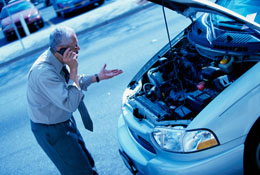
A flooded engine is one of the common problems faced by people who own carbureted cars. A carburetor is a device that performs the task of blending the right quantity of fuel with air, which in turn facilitates the smooth running of the engine. If the amount of fuel blended with air is not sufficient, the engine will run lean. On the other hand, mixing too much fuel with the air will lead to flooding of the engine. Due to the flooding of the engine, the internal combustion engine will either not start or might stall while you try to drive the vehicle. Moreover, this will also cause wastage of the fuel. Technology has advanced and cars come with electronic fuel injectors, which facilitate a more accurate fuel and air measurements, thereby ensuring that the air-to-fuel ratio is accurate. However, problems can arise in cold weather, when more fuel is injected for cold start. Here are some steps for sorting out this problem.
Signs of a Flooded Car Engine
How would you know whether your engine is flooded? An indication that your vehicle’s engine may be flooded would be the tell-tale smell of fuel or gas. The emission of dark smoke from the vehicle’s exhaust too, is an indication of this car problem. Despite repeated turns of the key in the ignition, your attempts to start the vehicle might fail because of this problem. Don’t make many repeated attempts at starting the engine as that would just worsen the condition. If your vehicle’s engine is flooded then you would not be able to start it unless the rich air-fuel mixture is cleared out. Though this car problem is faced by those who own cars that are equipped with a carburetor, at times cars with modern fuel injectors might also have this problem. Instances of the engine getting flooded are usually high during the winter months or when the accelerator has been unduly pumped in an attempt to start the vehicle. This excess pumping could result in the excess fuel soaking the spark plugs of your car. If you own a car that has a carburetor, problems could arise if the carburetor is not clean.
Fixing a Flooded Car Engine
If the spark plugs are soaked in fuel, then they would be unable to create the amount of voltage that is needed to create the spark that brings an engine roaring into life. Most manufacturers put an advisory on not to pump the gas pedal while you are starting the vehicle. If flooding does happen frequently, then you may also want to have a look at your vehicle’s fuel injector. Make sure that the injector is not covered in muck and dirt. If it is, then clean it using a fuel injector cleaner.
If the engine seems to be flooded, halt all attempts at starting the vehicle. Open the hood and let the excess fuel evaporate. Wait for a couple of minutes. Now, try to start your car without pushing down on the gas pedal. It should start, if it doesn’t, then take a look at the spark plugs and dry them out and then start the car again.
What you basically need to do is ensure that air-fuel balance is restored. Hold the gas pedal to the floor. It is important not to pump the pedal here. Keeping the pedal down opens the car’s throttle and allows that rush of air into the engine. Keep on cranking the engine for a couple of seconds. Thereafter, wait and start again, without releasing the pedal. Keep doing this until the engine finally comes into life. Once the car starts, release the gas pedal. If it doesn’t work, then let a mechanic do the job of identifying the problem. To prevent carburetor or fuel injector problems in future, make sure that your car is regularly serviced and its key components are kept clean.
So, follow the aforementioned instructions, if the car engine gets flooded. These steps might help bring the engine back to life. If these don’t work, leave the job of car repair to the experts.